
Health 'Insurance' at Sea: 1 2 3 4 5 6 7 8 9 10 11 12 13 Next>>
Health 'Insurance' at Sea During the Golden Age of Piracy, Page 4
Intermediate Health Care
"...so must it be owned, that a Just and Charitable Care in these Matters will much contribute, not only to the Preservation of the Seamen, but to the confirming in them a hearty Love and Affection to the Publick Service: And as it were much to be wished, that some speedy Care were taken towards the Reception of Poor, Maim'd... Seamen" (Josiah Burchett, "To the Reader", Memoirs of Transactions at Sea During the War with France, 1703, not paginated)
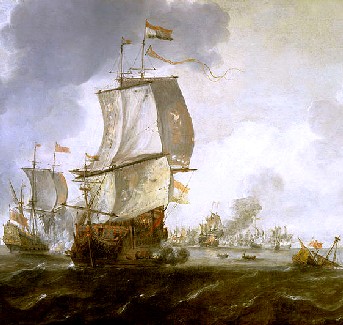
Artist: Reiner Nooms - A Battle of the First Dutch War (c. 1654)
In addition to providing a qualified surgeon to care for men wounded at sea, there was a need to find a place where men could recover from wounds and illnesses contracted at sea when more than just immediate care was required. Facilities for Intermediate care - defined here as requiring a few weeks to a few months to fully heal - was necessary.
Like other aspects of health care leading up to the golden age of piracy, the merchant companies and communities that depended on merchant vessels spearheaded the effort to provide care for wounded sailors. The Laws of Oleron were among the first to broach the idea of intermediate care, a concept which was carried forward into the golden age of piracy.
However it was under the navy that such efforts were able to truly blossom, particularly during times of war. The navy had always been concerned for the welfare of its sailors, but the practical methods for dealing with this concern became most apparent beginning with the First Dutch War in 1652.
While little is directly recorded about the pirate's methods for intermediate health care provision, there are a variety of comments and policies that pirates put into place that at least hint at their approach to intermediate health care.
Intermediate Health Care - Merchant Ships
The 12th Century Laws of Oleron originally created to govern the rules of shipping for the French Île d'Oléron formed the basis of Admiralty Law governing most of Europe at this time as discussed in the previous section.
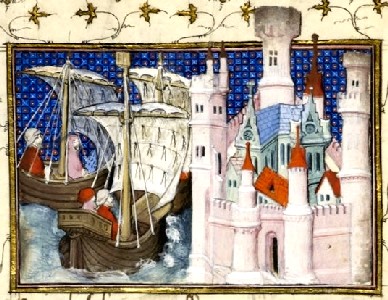
Duke of Salisbury Arriving at Conway From
the Catalog of Illuminated
Manuscripts in the British Library (1319)
Article seven of these laws stated that when a Mariner became ill, the ship's master was to "cause him to be laid in a house, with all sustentation necessary and [such as is] usual in the Ship; but shall not stay in the Ship until he be Healed"1.
The Laws of Wisby (from Sweden) which date to 1361 include rules for both land- and sea-based wounds received by mariners. Law 18 addresses land-based care stipulating, "If a Mariner, being ashore about the Master's or the Ship's Business, happen to be wounded, the Ship shall be at [incur] the Charge of his Cure." Law 19 is concerned with sea-based care: "In Case a Mariner falls sick, and that it is thought convenient to carry him to Shore, the Law is, That the said Mariner shall be there kept and maintained as if he were on Board, and attended by a Ship-boy."3
The focus of intermediate health care according to such laws was to get the patient on land where he could be healed. This is partly because the ships did not have the facilities, room or personnel to effectively deal with sick men. (Keep in mind that merchant ships were loaded with goods and typically maintained as small a crew as would serve their needs.) This focus on land-based care was probably also partly because the sea air, weather and cleanliness of the ship were not viewed as conducive to good health. In his book on fevers, sea-surgeon James White explains that just as
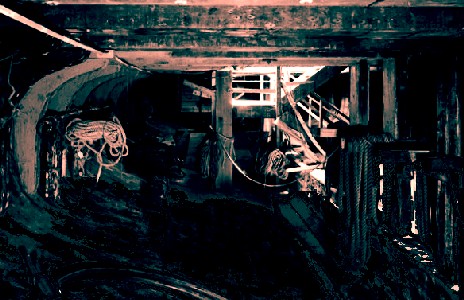
Ship's Hold, Schooner WAWONA
in the hot Countries, where the Air is Hot, and a Multitude of People breathing, and constantly perspiring in a close place, such as is a Ship’s Allop [Orlop deck - where surgery was performed during battle], or Lower-deck, next [one above] the Hould, where is the entry to a certain vacant space, near the Ship’s center, which leadeth to the bottom…and is called the Well; several times there is occasion for some People to go down, to examine the quantity of the Water [in the hold], and in some Ships to bore an Augur-hole thro’, to let in as much as will preserve a good Air.3
Naval physician William Cockburn thought that cold conditions created fevers. He worried that men "being got drunk, and not being able to crawl into their Hammocks,
Photo: Kronan boatbuilder - Hammocks on the Gun Deck, Kalmar Museum
they spend the Night fast asleep upon the cold Deck, and contract those Sicknesses that attend an Interruption of Perspiration"4. Cockburn's theory was when it was cold, a man's perspiration failed to escape, instead going into the blood and causing it to break down faster than normal. This heated the body, causing a fever.
Around 1630-40 Nathaniel Boteler explained the dangers to health of the ship's condition. He noted that the "cabins [are] no better than nasty holes, which breed sickness... so that all long voyages, especially to the southwards, the lodging of the common men in hammocks is far more wholesome and preferable."5
This recognition of the importance of healing on land continued through the golden age of piracy. Writing shortly after the golden age of piracy in 1742, sea surgeon John Atkins explained that while stationed in Guinea he "moved the Sick on Shore to the best Houses and Conveniences that could be hired, washed the Decks every Day, did not suffer them to work in the Heat of the Sun, (excessive under the Hills, from ten to four in the Afternoon,) nor to lay at the Tents, avoiding by that the Opportunities of Irregularity, and the Dampness and Dews they became exposed to afterwards."6
Not all merchant plans relied exclusively on land-based care, however. The 1553 articles of
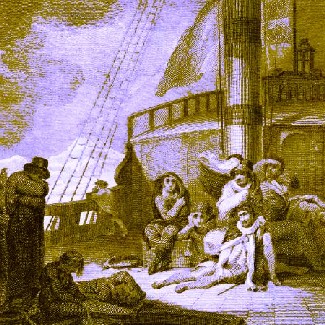
Death of Sir Hugh Willoughby During the Company of Merchant
Adventurers' First Voyage (1554)
the Company of Merchant Adventurers stated that "the sicke, diseased, weake, and visited person within boord, [is] to be tendred, relieved, comforted, and holpen [helped] in the time of his infirmitie, and every manner of person, without respect, to beare anothers burden."7 This company was formed by Richard Chancellor, Sebastian Cabot and Sir Hugh Willoughby to send three ships to find a new trade route to China and the Spice Islands in 1653. The lack of familiar lands they expected to encounter during their voyage was likely the reason they planned to keep men on the ships rather than put them on shore.
The East India Company faced a similar situation. Although their 1621 Lawes don't address the way sick and wounded men are to be handled, their Surgeon General John Woodall discusses cures to be used on board the East Indiamen that could take a month or more8. This suggests that the men were treated shipboard, which may have been the best place to deal with sick men in many of the foreign environments where the Company did business.
However, East India ships did sometimes resort to a compromise between land- and sea-based care when it was possible. East India Company sailor Edward Barlow discussed such a situation in his Journal in 1670 when the East Indiaman ship Experiment stopped at the Island of Johanna (today part of Comoros). "[W]e put our sick men on shore, ...and making a tent there... the sick men lay in the tent, and having good refreshing [from scurvy], recovered their health apace."9
Privateer William Dampier's account notes that they likewise stopped several times to set up tents for the ill. In 1684, they visited Juan Fernandez Island where they stayed sixteen days, with "our sick Men were ashore all the time, and one of Captain [John] Eaton's Doctors (for he had four in his Ship) tending and feeding them with Goat and several Herbs, whereof here
is plenty growing in the Brooks; and their Diseases were chiefly Scorbutick [Scurvy]."
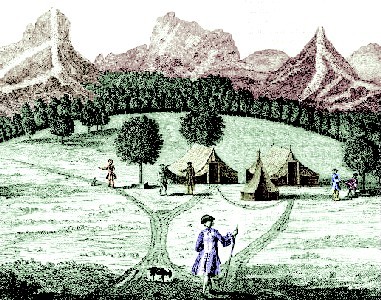
Tents on Juan Fernandez, From Voyage Autour du Monde, Richard Walter (1751 )
10 In the Galapagos islands, Dampier explains, "we made a Tent ashore for Capt. [John] Cook who was sick."11 While at Huatulco, Mexico in 1685, "Captain [Charles] Swan, who had been very sick, came ashoar, and all the sick Men with him, and the Surgeon to tend them."11
Dampier himself spent time in a tent ashore where he was sweated to treat his 'Dropsie' (Edema). (Sweating was believed to be a way to purge bad humors from the body.) He explains that he was "covered all but my head in the hot Sand: I indured it near half an hour, and then was taken out and laid to sweat in a Tent."12
Woodes Rogers privateering voyage of 1709-1711 also includes several instances of setting up tents for the sick, including Juan Fernandez Island13. They also put sick men ashore at Port Pences where Rogers reported that "the sick who are now much better than when we came to the Island, neither the Weather nor the Air here being half to bad as the Spaniards represented, [so we] got the sick Men into their Tents, and put the Doctors ashore with them."14 Intermediate health care was clearly a concern for merchant vessels, with concern for the air and weather having a strong influence on where treatment took place.
The East India Company actually provided hospitals for its sailors in the mid 17th century. Facilities were located at "Madras, Bombay and Calcutta, while medical services were also provided at Bencoolen, China and St Helena.
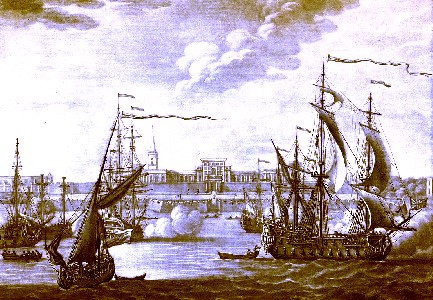
Artist: Elisha Kirkall - Fort_William in Calcutta (1735)
"15 The East India's Madras hospital was the first Western hospital in India. It was started in November of 1664 at Fort St. George "to minister to sick soldiers of the East India Company", by Edward Winter, a factor acting on behalf of the company.16 The hospital in Bombay (now Mumbai) was considered in 1670, but was not actually begun until 1676 by Gerald Aungier of the company.17 The hospital in Calcutta was begun in 1707 by the Council of Fort William, a fort built under the auspices of the East India Company in 1700.18 The East India Company's Bencoolen Factory (factory here not being a manufacturing plant, but an establishment for the company's representatives) was established in 1690.19 When a hospital was established is not clear. However, the site proved to be very sickly to the inhabitants with many suffering from malaria and dysentery.20 St. Helena was given a royal charter to the island in 1661 which "gave the Company the sole right to fortify and colonise the island 'in such legal and reasonable manner the said Governor and Company should see fit'."21 However, the first hospital apears to have been built after the golden age of piracy in 1742.22
1 Gerard Malynes, Consuetudo, ev., Lex Mercatoria: Or, The Ancient Law-Merchant in Three Parts, 1685, p. 103; 2 Gerard Malynes, “The Ancient Sea-Laws of Oleron, Wisby and the Hanse-Towns, Still in Force, The Ancient Law-Merchant, 1686, p. 16; 3 J. White, De recta sanguinis missione, or new and exact observations of fevers, 1712, p. 118; 4 William Cockburn, Sea Diseases: Or a Treatise of Their Nature, Causes and Cure, 1736, p. 97; 5 Nathaniel Boteler [Butler], Boteler's Dialogues, Edited by W.G. Perrin, 1929, p. 359; 6 John Atkins, The Navy Surgeon, 1742, p. 359; 7 Cheryl A. Fury, "Health and Health Care at Sea", The Social History of English Seamen, 1485-1649, p. 224; 8 For example, see John Woodall, the surgions mate, 1617, on treating dysentery, p. 221; 9 Edward Barlow, Barlow’s Journal of his Life at Sea in King’s Ships, East and West Indiamen & Other Merchantman From 1659 to 1703, p. 184; ; 10 Dampier, William, Memoirs of a Buccaneer, Dampier’s New Voyage Round the World, p. 70-1; 11 Dampier, p. 84; 12 Dampier, p. 164; 13 Dampier, p. 322; 13 Woodes Rogers, A Cruising Voyage Round the World; p. 74; 14 Rogers, p. 119; 15 Peter Earle, Sailors - English Merchant Seamen 1650-1775, p. 137; 16 Zubeda Hamid, " The medical capital’s place in history", The Hindu, 8/20/2012, updated 6/4/2013, accessed on the internet 3/6/16; 17 BT Basavanthappa, Fundamentals of Nursing, 2002, p. 121 and "St. Thomas Cathedral, Mumbai", wikipedia.com, gathered 3/6/16; 18 "IPGMER and SSKM Hospital", wikipedia.com, gathered 3/6/16; 19 Marguerite Eyer Wilbur, The East Indian Company: And the British Empire in the Far East, 1945, p. 216; 20 "British Bencoolen", id.wikipedia.org, translated from Indonesian, gathered 3/6/16; 21,22 "A Brief History", sainthelenaisland.info, gathered 3//6/16
Intermediate Health Care - Navy
"The most favourable circumstances connected with the "King's service, which are not equally enjoyed in that of the merchant, are, in the first place: —The great care and attention paid to the sick." (Hints on the impressments of seamen, 1827, p. 28)
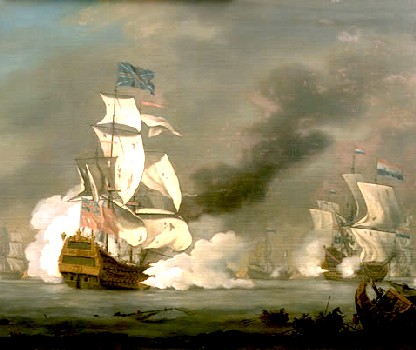
Artist: Robert Woodcock - A Battle Between English and Dutch Ships (early 18th c.)
Although the above quote is a hundred years after the end of the golden age of piracy, the sentiment still seems to have been relevant to the late 17th and early 18th centuries. No sea-going group under study went to as much trouble to provide intermediate care for sick and hurt men as the British navy.
Beginning with the preparations for the First Dutch War, they established a board, usually referred to as the Sick and Hurt Committee (also referred to as the Sick and Wounded Committee and similar names), for upcoming wars which the government entered. This was done to administrate and manage the the health care provided to the ill and wounded sailors in the course of their service. Each Sick and Hurt Board would typically be dissolved shortly after the end of the war for which it was established up to the end of the golden age of piracy. A 'permanent' Sick and Hurt Board that functioned during both war and peace time was not established until after the end of the golden age of piracy in 1740s.1
One result of this board's activities was the requisition of land-based hospitals for a war which was to lead to the establishment of the first English naval hospital in the early 18th century. Another result was creation of a variety of hospital ships which would either move with the fleet or be stationed in English harbours to provide intermediate wound care at the scene of the battle. Both of these elements will be discussed in detail.
;1 P.K. Crimmin, "The sick and hurt board and the health of seamen C. 1700–1806", Journal for Maritime Research, 1:1, 1999, p. 48
Intermediate Health Care - Navy: The Sick and Hurt Commission
The Sick and Hurt Commission (also called the Commission for the Sick and Wounded by some sources) had its roots in the Commonwealth. "The principle that the State should provide for those who had suffered in its service was laid down by the Long Parliament [1640-60] in 1642"1. Care was first to be applied to soldiers wounded in the English Civil War (1642 -1651) and then gradually expanded to include Navy sailors.
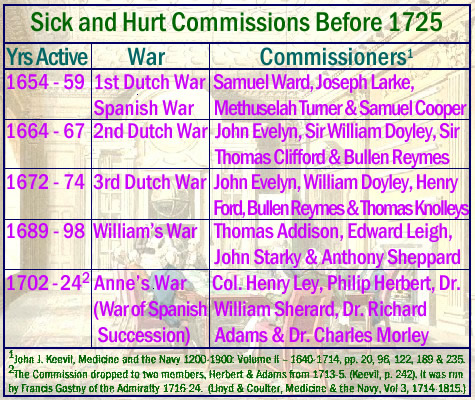
Chart of the Five Sick & Hurt Commissions Up to 1725.
Background Image: Board Room of Admiralty (1808}, Thomas Rowlandson & Augustus Pugin
At first the duties associated with orchestrating the care of the sick and wounded was handled by Navy Office. However, as time went on, such tasks became more onerous and demanding. "It was their excessive claim on the time of the Navy Office that ultimately led to medical, financial and administrative matters being transferred to the care of another authority"2.
The first Sick and Hurt Commission was discussed in the summer of 1653 being finally appointed in 1654. It remained active until near the end of the Anglo-Spanish War [1654 - 1660], being quietly dissolved around 1659.3 With this Commission as a template, a new Sick and Hurt Commission was set up for each war that followed through the end of the golden age of piracy. (See the chart for further details of each Commission.)
In addition to the commissioners, there were agents representing the Commission. During the fifth iteration of the Sick and Hurt Commission, such agents, "generally surgeons, [were located] at outports; Deal, Dover, Fareham, Gosport and Portsmouth, Plymouth,
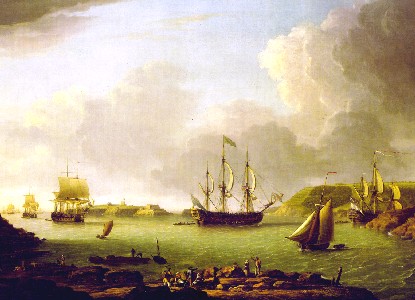
Artist: Dominic Serres the Elder - Return of a Fleet to Plymouth Harbour (1766)
Rochester, Yarmouth, Guernsey, Jersey and Kinsale."4
After each war ended, the Commission set up for it was typically dissolved within a year or so. For example, the third Commission was dissolved in 1674 "on grounds of economy... and, in future, commanders were to land no more sick: they were to be treated on board ‘as hath been always practised in time of peace'."5
One exception to this relatively rapid disbanding was the fifth Commission, which was in existence long after the War of Spanish Succession. It remaining in place to handle the details of pensions and the long-term effects of the sick and wounded, albeit at a reduced size. This post-war extension of the Sick and Hurt Commission had two members from 1713-15 and only a single member - Francis Gastny - from 1716 - 1724.6
1 J.R. Tanner, Samuel Pepys and the Royal Navy, 1920, p. 48-9; 2 John J. Keevil, Medicine and the Navy 1200-1900: Volume II – 1640-1714, p. 5; 3 Keevil, p. 26; 4 P.K. Crimmin, "The sick and hurt board and the health of seamen C. 1700–1806", Journal for Maritime Research, 1:1, 1999, p. 51; 3 Keevil, p. 130; 6 Christopher Lloyd & Jack L. S. Coulter, Medicine and the Navy 1200-1900, Volume III - 1714-1815, p. 3
Intermediate Health Care - Navy: The Sick and Hurt Commission Duties
The duties of the Sick and Hurt Commissions were extensive. They were concerned for ways to relieve the sick and wounded, but they also had to provide for the 'widows, children and impotent parents' of sailors who had been killed in the service since 1648. They had to take care of prisoners of war - both wounded and not. They were responsible for looking into the status of the Chatham Chest to make sure it was solvent.
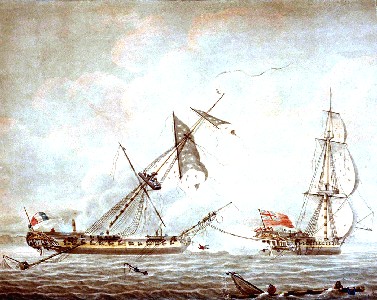
Artist: Robert Dodd - HMS Blanche Towing Prize Ship la Pique (early 19th c.)
(The Chatham Chest was an long-standing paid-in plan for taking care of wounded soldiers which will be discussed in detail later.)
The Commissioners were also concerned with managing their share of the prize-money. This was a result of policy set forth in 1652. The Admiralty Committee ordered "one-tenth of the value of all prizes [enemy nation ships taken by the navy and privateers] should be used for defraying the charges for sick and wounded, for the relief of widows, children and other dependents of men killed on active service and for the award of medals."1
The Sick and Hurt Commissions also had to make sure that seaports were ready and had adequate medical stores to receive the wounded as they were brought ashore. They had to make sure wounded men were sent to the hospitals 'immediately after being set on shore' and worked with various land-based hospitals to make sure they were prepared to care for the wounded men and had adequate bed space available. When there weren't enough hospital beds at the hospitals, the Commission was to arrange with local houses to house and nurse the men. Once men were healed, they had to see that they were returned to their ships.2
Sick and Hurt Commissioners also had regional duties as well, with

Artist: Sir Godfery Kneller - John Evelyn (1687)
commissioner John Evelyn - a member of the second and third Commissions - providing one of the more proactive examples of how a commissioner
could handle such responsibilities.3 When the second rate naval vessel London blew up in 1665 at the Nore (a sandbank in the Thames), Evelyn "went immediately to the coast and saw the burned survivors landed."4 He also inspected ships after battle to see and report on their condition. For example, he reported that the first rate ship Prince Royal "had between thirty and a hundred cannon-shot in her hull" after a battle in June of 1665.5
As a result of such actions, the fourth Commission was directed to maintain regional concerns "regarding sick and wounded seamen landed from ships similar to those of John Evelyn and his colleagues."6
Of course, each iteration of the Sick and Hurt Commission had different duties, depending on the Admiralty's focus and direction. Sometimes duties were added. The fifth Commission was not only responsible for caring for prisoners of war, it also had to arrange ransoms, search for escaped prisoners and investigate plots by the prisoners to escape.7
Other times, duties were removed. The third Commission had initially been responsible for gratuities to windows and orphans like its predecessors, but a new commission was formed in 1653 which assumed this responsibility.8
Each Commission's efforts had to be guided by what was happening to the sailors as well. The fourth Sick and Hurt Commission faced fewer battle casualties than previous commissions, but had greater problems with illness.
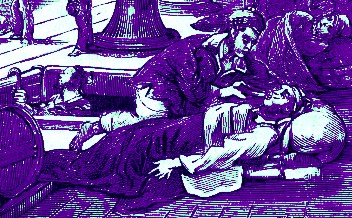
Artist: Lucian Totain (1885)
Treating the Sick, From Hygiène et médecine des deux sexes, p. 1285
Historian John Keevil notes that "sickness occurred principally on foreign stations and, since the mortality was high, constituted a manning rather than a hospital problem. ...a number of ships returned with many sick, and then provision must be made for their accommodation ashore."9
It is notable that many of these Commissions duties were more concerned with financing and logistics than direct care of the men. "Most of the things which affected health; diet, ventilation, cleanliness, over-crowding, damp and lack of clothing, were often the business of other branches of naval administration, and improvements in these areas were not within the power of the Sick and Hurt Commissioners. But the whole naval establishment was concerned to improve the health of seamen."10 Still, the Commission did have a role in facilitating health care improvements. Such ideas were sent to the Admiralty who referred them to the Sick and Hurt Commissioners "for report, comment or estimates of likely cost."11
1 John J. Keevil, Medicine and the Navy 1200-1900: Volume II – 1640-1714, p. 7; 2 Keevil, p. 5; 3 J.R. Tanner, Samuel Pepys and the Royal Navy, 1920, p. 49; 4 Keevil, p. 83; 5 Keevil, p. 84; 6 Keevil, p. 189; 7 Keevil, p. 237; 8 J.R. Tanner, Samuel Pepys and the Royal Navy, 1920, p. 49; 9 Keevil, p. 189; 10 P.K. Crimmin, "The sick and hurt board and the health of seamen C. 1700–1806", Journal for Maritime Research, 1:1, 1999, p. 59-60; 11 Crimmin, p. 53

